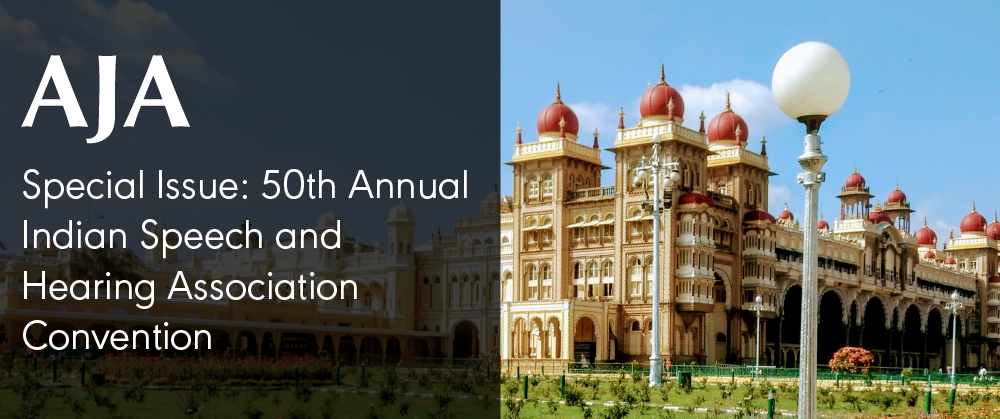The Indian Speech and Hearing Association (ISHA) was founded in December 1967. Since then, the organization has evolved to comprise speech-language pathologists, audiologists, and scientists throughout India. ASHA Journals proudly presents a special issue of the American Journal of Audiology (AJA), which offers a selection of 12 research articles, all presented at ISHA’s 50th annual convention, hosted by the Mysuru chapter of ISHA.
Special Issue Co-Guest Editor U. Ajith Kumar writes that this special issue reflects the current trends of audiology research in India and covers a wide range of topics in audiology. The first three articles focus on assessment of vestibular function. Additional articles cover topics as diverse as (1) recording cortical evoked auditory potentials, (2) pre-attentive cortical neural correlates, (3) personal sound amplification products (PSAPs) and hearing aids, and (4) working memory.
Kumar explains that the collection addresses issues of interest for clinicians and researchers alike. Describing “Consumer Opinion of Personal Sound Amplification Products (PSAPs): A Preliminary Sentiment Analysis” by Lakshmi, Rout, Morris, and Smaldino, he writes that “the findings may be utilized in framing guidelines for distribution and use of these devices.” He also highlights “The Effect of Fatigue on Working Memory and Auditory Perceptual Abilities in Trained Musicians” by Jain and Nataraja, saying that this research hints at the role of cognitive factors in audition. See “Explore This Issue” below for links to these and many other interesting articles from the collection, or read the full issue here.
We would like to thank Guest Editors U. Ajith Kumar, Sandeep Maruthy, and G. Nike Gnanateja for putting together this special issue. Dr. Kumar would also like to thank AJA Editor-in-Chief Sumitrajit Dhar and the entire editorial team at AJA for their help with this historic collection. We hope you enjoy this special issue of AJA!
Explore the Issue
Anupriya E., & Kumar, K. (2019). Test–retest reliability of cervical and ocular vestibular evoked myogenic potential with simultaneous and sequential recording. American Journal of Audiology, 28, 414–421. https://doi.org/10.1044/2019_AJA-IND50-18-0087
Devaraju, D. S., Kumar, U. A., & Maruthy, S. (2019). Behavioral and neural correlates of auditory n-back task in adults with and without stuttering. American Journal of Audiology, 28, 471–482. https://doi.org/10.1044/2019_AJA-IND50-18-0101
Jain, S., & Nataraja, N. (2019). The effect of fatigue on working memory and auditory perceptual abilities in trained musicians. American Journal of Audiology, 28, 483–494. https://doi.org/10.1044/2019_AJA-IND50-18-0102
Kalaiah, M. K., Poovaiah, S., & Shastri, U. (2019). Threshold estimation using “chained-stimuli” for cortical auditory evoked potentials in individuals with normal hearing and hearing impairment. American Journal of Audiology, 28, 428–436. https://doi.org/10.1044/2018_AJA-IND50-18-0090
Lakshmi, M. S. K., Rout, A., Morris, A., & Smaldino, J. (2019). Consumer opinion of personal sound amplification products: A preliminary sentiment analysis. American Journal of Audiology, 28, 450–459. https://doi.org/10.1044/2019_AJA-IND50-18-0103
Megha & Maruthy, S. (2019). Auditory and cognitive attributes of hearing aid acclimatization in individuals with sensorineural hearing loss. American Journal of Audiology, 28, 460–470. https://doi.org/10.1044/2018_AJA-IND50-18-0100
Nisha, K. V., & Kumar, A. U. (2019). Pre-attentive neural signatures of auditory spatial processing in listeners with normal hearing and sensorineural hearing impairment: A comparative study. American Journal of Audiology, 28, 437–449. https://doi.org/10.1044/2018_AJA-IND50-18-0099
Singh, N. K., & Baral, T. L. (2019). Test–retest reliability of multicomponent tympanometry at 226-, 678-, and 1000-Hz probe tones over 10 sessions. American Journal of Audiology, 28, 516–523. https://doi.org/10.1044/2019_AJA-IND50-18-0097
Singh, N. K., Kumar, P., & Jha, R. H. (2019). A novel stimulation paradigm for obtaining interfrequency amplitude ratio of ocular vestibular evoked myogenic potentials. American Journal of Audiology, 28, 422–427. https://doi.org/10.1044/2019_AJA-IND50-18-0083
Singh, N. K., Raul, A., Malik, G., & Sao, T. (2019). Intersession variations in frequency tuning of ocular vestibular evoked myogenic potentials in healthy individuals. American Journal of Audiology, 28, 407–413. https://doi.org/10.1044/2019_AJA-IND50-18-0105
Swamy, S. P., & Yathiraj, A. (2019). Short-term reliability of different methods of contralateral suppression of transient evoked otoacoustic emission in children and adults. American Journal of Audiology, 28, 495–507. https://doi.org/10.1044/2018_AJA-IND50-18-0093
Yashaswini, L., & Maruthy, S. (2019). The influence of efferent inhibition on speech perception in noise: A revisit through its level-dependent function. American Journal of Audiology, 28, 508–515. https://doi.org/10.1044/2019_AJA-IND50-18-0098







